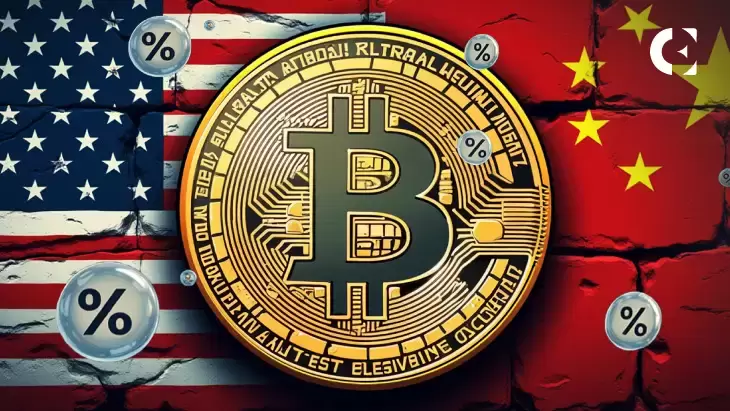 |
|
 |
|
 |
|
 |
|
 |
|
 |
|
 |
|
 |
|
 |
|
 |
|
 |
|
 |
|
 |
|
 |
|
 |
|
Cryptocurrency News Articles
Bitcoin Mining: The Hidden Force Driving BTC's Price
Nov 11, 2024 at 11:29 am
The world of Bitcoin, mining can seem like a complex and somewhat mysterious process. But what if we told you that Bitcoin mining is not just a technical

When it comes to Bitcoin, mining is not just a technical aspect of the cryptocurrency; it's a driving force behind its price. Understanding the link between the two can give you an edge when predicting market movements.
At its most basic, Bitcoin mining is the process that keeps the Bitcoin network running. It involves miners using powerful computers to solve complex cryptographic puzzles, and in return, they earn the right to add new transaction blocks to the blockchain. Think of the blockchain as an open, public ledger that records all Bitcoin transactions, ensuring transparency and trust.
However, Bitcoin mining is about much more than just recording transactions. It plays a key role in maintaining the decentralization of the Bitcoin network—one of the core values of the cryptocurrency. Through mining, new Bitcoins are also introduced into circulation. This means that Bitcoin mining is directly tied to the supply of new coins, and therefore, the overall scarcity of Bitcoin.
But why does all this matter for the price? That's where factors like mining difficulty and hashrate come into play.
In simple terms, hashrate refers to the total computing power that miners contribute to the Bitcoin network. It's a measure of how much mining power is actively being used to verify transactions and secure the network. But hashrate is more than just a technical statistic—it has a direct impact on Bitcoin's price.
Here's how: When the price of Bitcoin rises, mining becomes more profitable. As a result, more miners are attracted to the network, contributing additional computing power and boosting the hashrate. More miners mean more competition, and this increased mining activity contributes to greater network security and trust in the system.
The interesting part? A rise in hashrate can be an early signal of bullish sentiment in the Bitcoin market. When miners are more confident in the long-term price potential of Bitcoin, they are more willing to invest in the infrastructure required for mining. This increased demand for mining power can also contribute to an upward price movement.
In short: A rising hashrate is often a sign of increasing demand for Bitcoin, which can push the price up.
While hashrate indicates the amount of mining power on the network, mining difficulty controls how hard it is to mine Bitcoin. Difficulty is adjusted every two weeks by the Bitcoin protocol to maintain a steady rate of block production (about every 10 minutes). When more miners join the network, the difficulty increases to keep the mining process competitive.
So, how does mining difficulty affect Bitcoin's price? The more difficult it becomes to mine Bitcoin, the fewer new coins are created on a daily basis. This slowdown in new coin production can make Bitcoin feel more scarce, especially if demand remains high. And as we know, scarcity drives value.
When difficulty rises, miners may need to invest in more powerful hardware to stay competitive, and this increased cost of mining can influence their decision to keep mining or to drop out of the network. If difficulty increases but miners continue to participate, it suggests strong confidence in Bitcoin's future price—and this kind of confidence can translate into rising demand and, ultimately, rising prices.
To put it simply: The more difficult it is to mine Bitcoin, the scarcer new coins become, which can lead to higher prices if demand for Bitcoin stays strong.
If there's one event that Bitcoin enthusiasts look forward to—and one that has historically had a significant impact on Bitcoin's price—it's the halving. Every four years, the reward that miners receive for adding new blocks to the blockchain is cut in half. This event is part of Bitcoin's built-in monetary policy, designed to ensure that Bitcoin remains scarce over time.
Historically, each Bitcoin halving has been followed by a dramatic price increase. For example, after the 2016 halving, Bitcoin's price surged from around $600 to nearly $20,000 by the end of 2017. Similarly, following the 2020 halving, Bitcoin's price surged from about $6,000 to over $60,000 in the following year.
The most important thing to understand about halvings is this: They reduce the rate at which new Bitcoins are introduced to the market, creating an artificial supply constraint. If demand remains high—or even increases—this reduced supply often drives the price up.
The next halving, expected in 2024, will cut the miner reward from 6.25 BTC to 3.125 BTC, further tightening the supply. With fewer new coins entering circulation, Bitcoin's scarcity could increase, making it more valuable, provided that demand continues to grow.
The relationship between Bitcoin's mining process and its price is cyclical, and each factor influences the others in a continuous loop:
Disclaimer:info@kdj.com
The information provided is not trading advice. kdj.com does not assume any responsibility for any investments made based on the information provided in this article. Cryptocurrencies are highly volatile and it is highly recommended that you invest with caution after thorough research!
If you believe that the content used on this website infringes your copyright, please contact us immediately (info@kdj.com) and we will delete it promptly.
-

-

-

- The Crypto Market's Been Cooking Up Fresh Narratives This Year—from Bitcoin Crossing All-Time Highs to Solana's Gasless Memecoin Mania
- Apr 12, 2025 at 12:30 pm
- The crypto market's been cooking up fresh narratives this year—from Bitcoin crossing all-time highs to Solana's gasless memecoin mania. But here's what's flying under the radar
-

-

- Today, the broader cryptocurrency market experienced a significant sell-off, erasing $314.69 million in liquidations.
- Apr 12, 2025 at 12:25 pm
- Today, the broader cryptocurrency market experienced a significant sell-off, erasing $314.69 million in liquidations. According to metrics shared by Phoenix Group, a total of 108138 traders were liquidated
-

-

-

-




















![Crypto Otaku - CRYPTO CHAOS! 83K BITCOIN! CRYPTO RALLY!! XCN , JASMY , SWFTC LEAD!!! [Episode 228] Crypto Otaku - CRYPTO CHAOS! 83K BITCOIN! CRYPTO RALLY!! XCN , JASMY , SWFTC LEAD!!! [Episode 228]](/uploads/2025/04/12/cryptocurrencies-news/videos/crypto-otaku-crypto-chaos-k-bitcoin-crypto-rally-xcn-jasmy-swftc-lead-episode/image-1.webp)









































